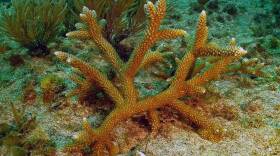-
The study to determine what impact a planned port dredge will have on nearby coral confirmed millions of coral, including one of the largest stands of wild staghorn coral left on the reef.
-
From Oct. 20-27, just under two dozen car-shaped artificial reefs will be lowered off the coast of South Beach, to create an underwater sculpture park and an artificial reef that organizers called the "first of its kind."
-
The artificial reef off Miami Beach will be an art installation, a restoration of the island's coral habitat and an underwater tourist attraction.
-
On this episode of "Florida Matters," we discuss how the future of Florida's corals hangs in the balance, HOA-issued speeding citations are raising privacy concerns in Sarasota and more.
-
Florida researchers to plant thousands of juvenile corals back into the wild thanks to a state grantExperts say climate change is the No. 1 threat to Florida's coral reefs right now, as they also battle stony coral tissue loss disease.
-
Elkhorn coral babies, affectionately called "Flonduran" corals by researchers at the Rosenstiel School at the University of Miami, were planted in Biscayne Bay on July 1. This is the first time internationally crossbred corals have ever been planted in wild reefs.
-
The researchers, with others from Honduras, are looking for ways to help reefs survive increased temps caused by global warming. The work could provide a blueprint for working across the Caribbean to share corals.
-
Finding more heat-resistant coral species could be the key to staving off their extinction as ocean temperatures are expected to continue rising.
-
Against the odds of a warming ocean, the next generation of corals heads out to sea.
-
The "coral defenders" are made of plastic called PHA. Similar to a potato starch, it naturally breaks down when exposed, especially to salt water.
-
Gov. Ron DeSantis said the plan, which took more than a decade to hammer out, failed to pave the way for artificial reefs in state waters and stripped Florida of managing its own wildlife.
-
Pillar corals were supposed to become "endangered" on Tuesday, but that was before a recent freeze pushed it back to March.
Play Live Radio
Next Up:
0:00
0:00
Available On Air Stations












